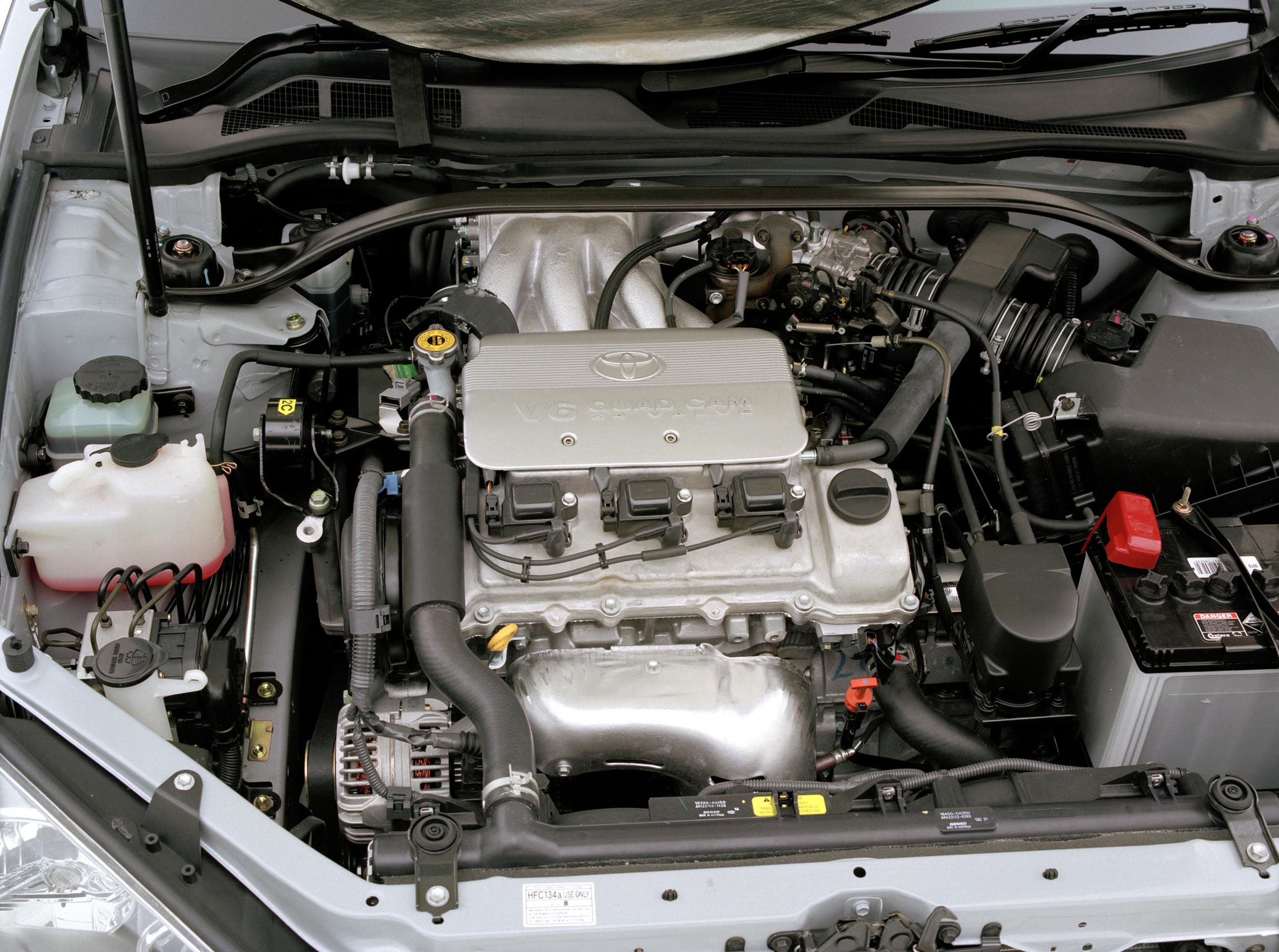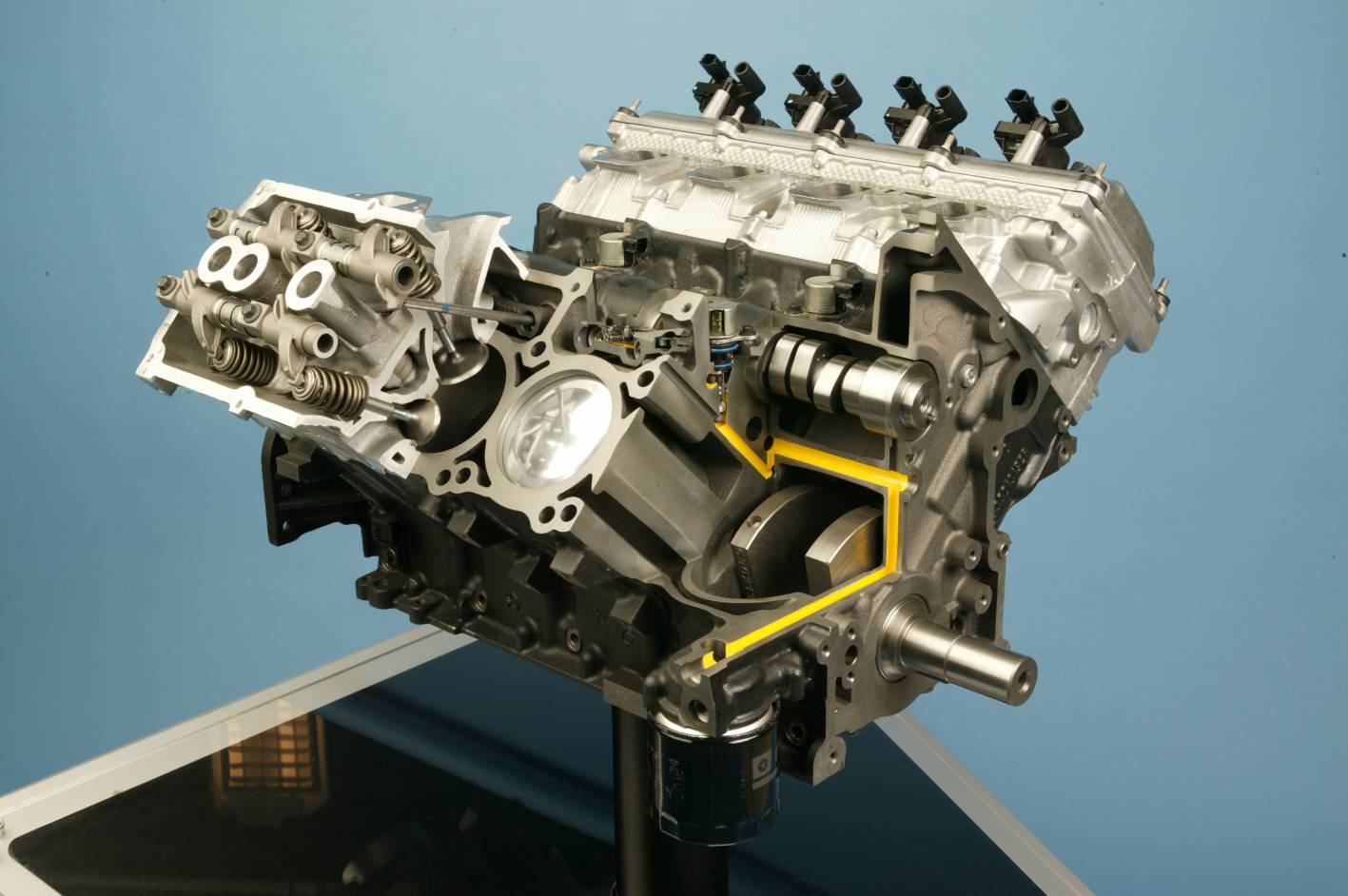Introduction
Toyota’s 1MZ-FE was a 3.0-litre petrol engine with a 60-degree ‘V’ angle. With its aluminium alloy cylinder block, the 1MZ-FE engine had a service weight of 151 kg and replaced Toyota’s 3VZ-FE engine. The 1MZ-FE was a non-interference engine.
In Australia, the 1MZ-FE engine was first introduced in the Lexus XV20 ES 300 and followed in the XV20 Camry and XV20 Vienta. For the Lexus XV30 ES 300, the 1MZ-FE was fitted with the Toyota’s ‘Variable Valve Timing – intelligence’ which provided variable inlet cam timing – this was the only 1MZ-FE engine to be so equipped in Australia.
| Engine | Trans. | Years | Peak power | Peak torque | |
|---|---|---|---|---|---|
| Toyota XV20 Camry | 3.0-litre petrol V6 | 5sp man., 4sp auto |
1997-02 | 141kW at 5200rpm | 279Nm at 4400rpm |
| Toyota XV20 Vienta | 3.0-litre petrol V6 | 4sp auto | 1997-00 | 141kW at 5200rpm | 279Nm at 4400rpm |
| Toyota XV30 Camry | 3.0-litre petrol V6 | 5sp man., 4sp auto |
2002-06 | 145kW at 5200rpm | 284Nm at 4400rpm |
| 149kW at 5200rpm | 289Nm at 4400rpm | ||||
| Toyota XX10 Avalon | 3.0-litre petrol V6 | 4sp auto | 2000-05 | 145kW at 5200rpm | 284Nm at 4400rpm |
| Lexus XV20 ES 300 | 3.0-litre petrol V6 | 4sp auto | 1996-01 | 149kW at 5200rpm | 290Nm at 4400rpm |
| Lexus XV30 ES 300 | 3.0-litre petrol V6 | 5sp auto | 2001-05 | 158kW at 5800rpm | 299Nm at 4400rpm |
1MZ-FE block
The 1MZ-FE engine had a deep-skirt, aluminium alloy cylinder block with six bolt main bearing caps. The 2995 cc 1MZ-FE had 87.5 mm bores – with a bore pitch of 105.5 mm – and an 83.0 mm stroke. Within the bores, the 1MZ-FE had press-fitted cast-iron cylinder liners. Furthermore, the cylinder banks had an offset 36.6 mm.
The cylinder block contained a water jacket through which coolant was pumped to cool the cylinders.
Crankshaft, connecting rods and pistons
The 1MZ-FE engine had a forged crankshaft with four main journals, nine semi-balance weights and roll-finished pins and journals. Crankshaft bearing caps were fastened using four plastic-region tightening bolts for each journal.
Attached to the crankshaft were sintered and forged connecting rods. Like the crankshaft, the connecting rods had plastic region tightening bolts.
The 1MZ-FE engine had aluminium alloy pistons with full-floating type piston pins which had snap rings fitted on both ends of the pins. Depending on its application, the piston skirt had a resin coating, molybdenum coating or Teflon coating. While the No.1 compression ring was made of steel, the No.2 compression ring was made of cast iron.
Cylinder head and camshafts
The 1MZ-FE engine had an aluminium alloy cylinder head and a carbon graphite-type cylinder head gasket. Within the cylinder head, the 1MZ-FE engine had cast iron alloy crankshafts. The exhaust camshafts were driven by a timing belt, while the intake camshafts were driven through gears on the exhaust camshafts. The scissor gear mechanism for the exhaust camshaft was used to control backlash and suppress gear noise. The camshaft journal was supported at five places between the valve lifters on each cylinder and on the front end of the cylinder head.
Acoustic Control Induction System (ACIS)
Certain applications of the 1MZ-FE featured an Acoustic Control Induction System (ACIS) which varied the length of the intake pipe to harness the effect of inlet pulsations to improve engine performance. ACIS consisted of:
- A bulkhead to divide the intake manifold into stages; and,
- An intake air control valve in the bulkhead which opened and closed to vary the effective length of the intake manifold according to engine speed and throttle valve opening angle.
The XV20 ES 300, XX10 Avalon and XV30 Camry had a two-stage ACIS, the XV30 ES 300 had a three-stage system.
Valves and non-VVT-i 1MZ-FE
The 1MZ-FE engine had four valves per cylinder with an included valve angle of 22.5 degrees (i.e. the angle between the intake and exhaust valves). The intake and exhaust valves were fitted with irregular pitch springs that were made of special valve spring carbon steel that was capable of following the cam profile at all engine speeds. Adjustment of valve clearance was done by means of an outer shim type system in which valve adjusting shims were located above the valve lifters – this permitted replacement of the shims without removal of the camshafts
The 1MZ-FE engine had 34.0 mm diameter intake valves and 27.3 mm diameter exhaust valves; valve stem diameter was 5.5 mm. Furthermore, intake valve lift was 7.85 mm and exhaust valve lift was 7.60 mm.
Non-VVT-i 1MZ-FE
For engines without Toyota’s ‘Variable Valve Timing – intelligence’ (VVT-i), the 1MZ-FE engine had valve overlap of 6 degrees, intake duration of 228 degrees and exhaust duration of 228 degrees.
| 1MZ-FE Valve Timing | ||
|---|---|---|
| Intake | Open | 4° BTDC |
| Close | 44° ABDC | |
| Exhaust | Open | 46° BBDC |
| Close | 2° ATDC | |
VVT-i 1MZ-FE
For the XV30 ES 300, the 1MZ-FE engine had ‘Variable Valve Timing – intelligence’ which could vary inlet valve timing to provide greater torque at low engine speeds and power at high engine speeds. With VVTi, the 1MZ-FE engine had valve overlap of -2 to 58 degrees, intake duration of 236 degrees and exhaust duration of 236 degrees.
| 1MZ-FE VVT-i Valve Timing | ||
|---|---|---|
| Intake | Open | -4° to 56° BTDC |
| Close | 60° to 0° ABDC | |
| Exhaust | Open | 54° BBDC |
| Close | 2° ATDC | |
- A housing driven from the exhaust camshaft; and,
- A vane coupled with the intake camshaft.
In this system, oil pressure sent from the advance or retard side path at the intake camshaft caused rotation in the VVT-i controller vane circumferential direction to vary intake valve timing. Inlet camshaft timing was varied according to engine speed, throttle position, accelerator pedal angle, engine coolant temperature, intake air volume and intake air temperature.
When the engine was stopped, the intake camshaft would be in its most retarded state because of the external force of the valve springs. At this time, a lock pin fixed the housing and the vane in the VVT-i controller. When the engine started, the lock pin was released by the hydraulic pressure.
Injection and ignition
The 1MZ-FE engine had sequential multi-point fuel injection with a hot-wire air-flow meter to measure intake air density.
The 1MZ-FE engine had Toyota’s ‘Direct Ignition System’ which consisted of six ignition coils and each coil fitted over a spark plug. The spark plug was located in the centre of the combustion chamber.
The 1MZ-FE engine had a compression ratio of 10.5:1 and a firing order of 1-2-3-4-5-6.
Exhaust
The 1MZ-FE engine had stainless steel exhaust manifolds. For 1MZ-FE engines without VVT-i, an exhaust gas recirculation (EGR) system EGR system: recirculated a portion of the exhaust gases through the intake to reduce the nitrous oxides in the exhaust gases.
For the Lexus XV30 ES 300, the main muffler included a variable back-pressure valve. The exhaust valve opened steplessly according to back-pressure, remaining closed at low engine speeds to reduce noise and opening at higher engine speeds for improved performance.




